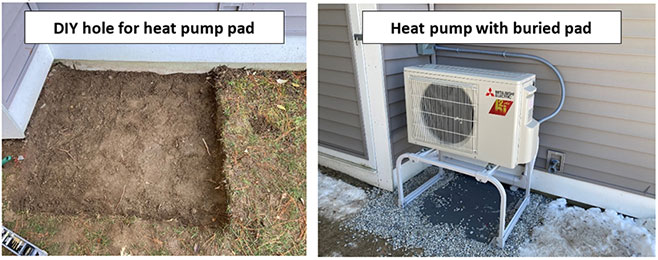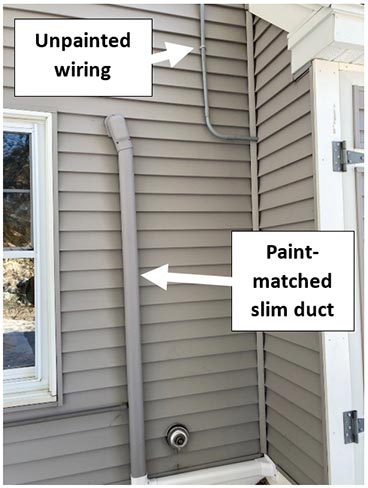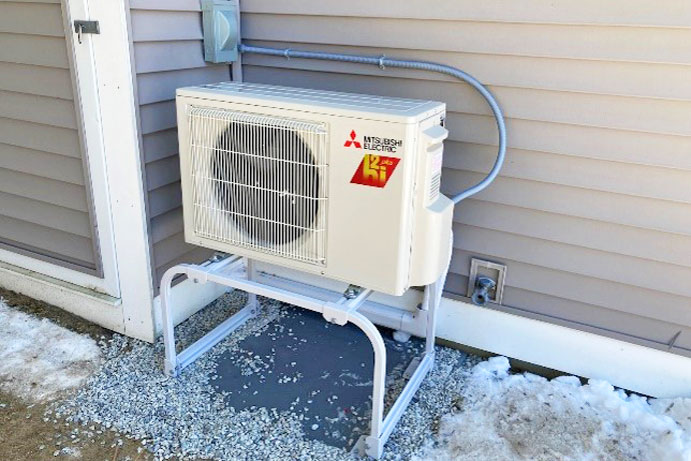Camryn Hansen, Zondits guest, 10/24/2023
I blogged previously about the numerous cumbersome steps it took to have heat pumps installed in my 100-year-old Maine house. In that blog I promised to publish future blogs exploring the topic of support—who or what would have made my process easier and how can we remove barriers to the extent that putting in heat pumps feels like a reasonable, achievable thing for most people?
To help answer these questions, I consulted with my friend Erica, whose recent heat pump journey provides an exemplary basis for my gnawing, growing fear that in the end, succeeding against climate change will have meant that enough of us were willing to donate uncivilized amounts of time, effort, and intellectual energy to navigating and ultimately surmounting the mountainous bureaucracies that define our modern existence.
Erica owns a condo in Portland, Maine governed by a homeowner’s association (HOA). In 2017, she was the first in her entire condo development to ask if she could put in a heat pump. The answer at that time was a hard no, for myriad reasons relating to aesthetics, fairness, safety, and precedent. When Erica pushed back, the HOA slowly started to crack, and she wedged her way in. Five years later, she finally persuaded the HOA to agree to consider letting her put in a heat pump. But coaxing a consummate yes out of them for the real-world installation required the following:
- Erica had to sign an elaborate “conditional consent form,” a legally binding document agreeing she would be liable for all sorts of things, including any damage to or caused by the heat pump unit even if it wasn’t related to anything she personally did. Before signing this formidable document, she consulted a lawyer and an insurance agent. While the lawyer said she wouldn’t personally be comfortable signing it, the insurance agent said it was typical of HOAs and probably nothing to worry about as long as a reputable installer put the heat pump in and she got regular maintenance on the heat pump (which is very important, by the way! Get it professionally cleaned every 1-2 years depending on your use). She also had to provide the HOA with detailed schematics of how and where the various heat pump components would be installed, and give the condo board several weeks to review them before they could be voted on at a board meeting.
- Upon review, the HOA judged that the normal plastic pad the heat pump sits on posed a tripping hazard and/or an obstacle for mowing machines, and they asked Erica to have a cavernous hole dug for the pad (at her own expense). When Erica got an estimate of $750 to dig such a hole, she and her 73-year-old dad went the Maine bootstrap route and dug it themselves, ultimately having to remove a substantial boulder and chainsaw through a forsythia root. They also had to have Dig Safe come out beforehand to make sure they wouldn’t hit any pipes or cabling in the dig.


- The HOA also said that it was aesthetically unacceptable for the slim duct that covered the piping from the condenser to be a different color than the outer wall of the condo building. So they gave Erica the name of the color of the vinyl siding and told her to go match it. She dutifully went to Sherwin Williams and had them create a custom paint of exactly the same color. By this time it was deep into Maine fall and getting too cold to paint outdoors. Having no area in her condo to safely prime and paint the nine slim duct pieces indoors, Erica had to hire a professional painter to do it for her.
- It turned out that the electrician could not put some of the wiring into the slim duct as intended, which meant it had to sit against the wall in slightly the wrong color gray. Erica was terrified that the HOA would make her paint this wiring as well. In the end, thank goodness, they didn’t.
What type of support would have helped most?
Erica and I chatted at length about the kinds of resources and support that might have helped her in this process. First and foremost, since many of her barriers stemmed from belonging to an HOA, she said it would have been very helpful to receive guidance from a professional with specialized knowledge about dealing with HOAs—how to navigate the legal aspects and paperwork, coordinate the timing and execution of projects, and handle unexpected roadblocks such as the requirement to dig her own hole for the heat pump platform.
Different HOAs can have very different rules when it comes to things like air conditioners and heat pumps. Erica’s, for instance, has a rule that residents may not install an A/C unit in the window of the first floor (the primary living space). Because such differences between HOAs can create inequities in the choices people can make around their energy use, energy costs, fuel source, and even comfort level, Erica suggested something interesting, which is that every HOA should potentially have to submit their requirements for installing heat pumps (or other efficient upgrades) to an organization like Efficiency Maine, who could review them and decide whether they pose an unreasonable burden to residents.
Alternatively, we thought, an organization like Efficiency Maine (or regional organizations like The New Buildings Institute, CEE, or NEEP) could proactively issue educational guides to HOAs about heat pumps that include information about how they work, the benefits of installing them, and FAQs along with specific guidance around what an HOA should reasonably require of a homeowner looking to install heat pumps, what the ideal installation process should look like, and who should be responsible for the various steps. Educational guides could also facilitate heat pump conversion in historic districts and buildings, which are another thorn in the side of would-be heat pumpers.
What about non-HOA homeowners? Can’t they get away with less support?
The emerging answer appears to be that it depends on both the home and the homeowner. For many people, switching to heat pumps is a straightforward and relatively easy process. But the rest of us, especially people in older homes and/or who lack the relevant technical knowledge, could really use professional guidance, and we don’t know what we don’t know. For me, the guidance I needed was less about cutting through red tape and more about the project steps—knowing what tasks had to be done, when and by whom, and then coordinating and working with the various contractors to make sure everything got done correctly at the right time. Although I technically “succeeded” in installing heat pumps in my 100-year-old house without this guidance, some smaller but important things ended up falling through the cracks. For example, because I replaced a thermostat-controlled radiator with a remote-controlled heat pump in the same room where my only thermostat was located, my thermostat does not accurately reflect an average temperature in the house anymore and can’t effectively control my natural gas-fueled boiler, which I still need to use (even if sparingly) in the winter. I should have had my thermostat moved to a different room when the heat pumps went in. But a year after my heat pump installation, I still haven’t gotten it moved. My heat pump installer said at the time that they couldn’t do it because it needed to be done by an electrician. The electrician I called said it needed to be an HVAC contractor. The HVAC contractor I called sent me back to the electrician, who finally agreed to come out after a 4-month wait but couldn’t promise that they would ultimately do the job when they got here, depending on how my thermostat is configured. Fingers crossed.
What about an Energy Navigator?
In other fields, there are professionals whose entire job consists of helping people navigate complex/technical/bureaucratic processes they’re unfamiliar with. These professionals are often called just that—Navigators. A notable example is the Navigators created as part of the Affordable Care Act to help people sign up for health insurance and Medicare. Given how fraught the journey can be for a homeowner to decarbonize/electrify/weatherize/increase the efficiency of any given home, it seems like interested consumers could really benefit from having access to an Energy Navigator.
At its most basic, an Energy Navigator could help streamline projects by taking on the project-coordinator-type role that Erica and I both played as homeowners trying to install heat pumps, and coordinate everything from initial paperwork to contractors to rebate forms. Or maybe Energy Navigators could play a larger role, by coming into a home at the beginning of the process and taking a look at the full home energy picture, everything from insulation to HVAC to appliances to energy bills, and then making actionable recommendations for the homeowner about the most impactful and cost-effective steps they could take to improve the energy use and comfort of their home. Once homeowners have made decisions about what projects they want to pursue, the Energy Navigator could help coordinate those projects, and we could avoid situations like Erica’s and mine where every homeowner who wants to make efficiency improvements finds themselves forced to reinvent their own customized version of the wheel.
Of course, there would need to be workforce development (and its requisite funding sources) to grow a crop of qualified Energy Navigators. To those currently trained as home and building inspectors, the additional training to become an Energy Navigator might not feel so dramatic. Certainly, workforce development is needed in all the trades involved in meeting the ambitious energy goals of states like Maine. We recently blew through our initial target of installing 100,000 heat pumps two years ahead of schedule, and set the bar even higher at 175,000 additional heat pumps installed by 2027. Though Maine has expanded heat pump workforce training programs in the Maine Community College System and has already trained 558 heat pump technicians to date, those looking to get a heat pump installed in late 2023 face weeks to months of wait time.
In the meantime, I will continue to blog on the topic of home efficiency upgrades and support as I learn more. Stay tuned!

